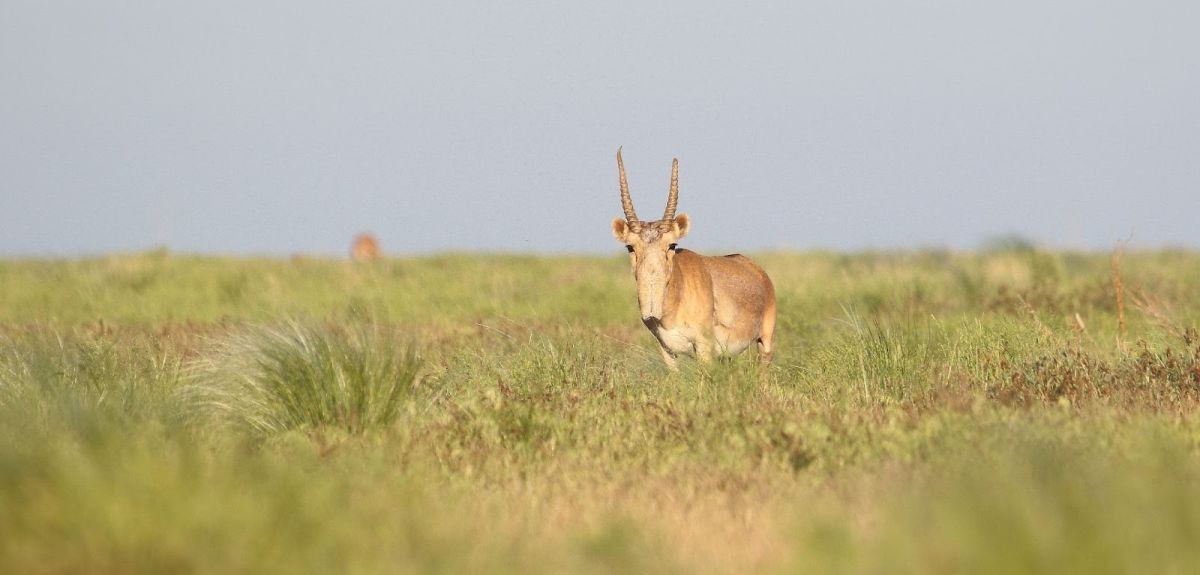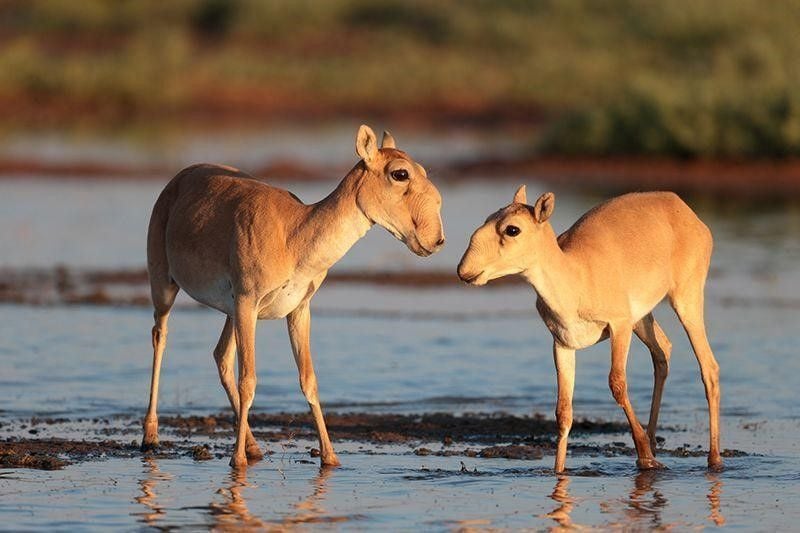
Unprecedented conservation triumph: Saiga antelope return from the red list
- Antelope, which roamed the Eurasian Steppe alongside woolly mammoths, has been restored from near extinction by conservation efforts.
The Red List status of the Saiga antelope has been changed from Critically Endangered to Near Threatened, thanks to effective national and international conservation efforts.
This rare triumph is thanks to significant conservation efforts over two decades, which have seen the remarkable recovery of Saiga populations in Kazakhstan from a perilous low in 2005 of just 39,000 to today’s estimated population of nearly 2 million. There has been a considerable effort to restore the population by the Kazakh and other range state governments, research organisations, national and international NGOs – see list below.
[The Saiga are] Small but tough animals that lived alongside woolly mammoths
Sir David Attenborough
Speaking on BBC Radio 4’s Today Programme [12 Dec], Oxford Professor Dame E.J. Milner Gulland, who is co-founder and chair of the Saiga Conservation Alliance, emphasised the importance of the cooperation involving governments, academics, charities – and especially local people.
‘Everyone was pulling in the same direction,’ she said. ‘Local people have to be able to move away into other livelihoods…there was a huge pull towards poaching.’
They [the Saiga] are a cultural symbol of the Steppe and symbolise…freedom
Professor Milner-Gulland
Saigas recently featured on BBC’s Planet Earth III, in which Sir David Attenborough maintained they were, ‘Small but tough animals that lived alongside woolly mammoths.’
Professor Milner-Gulland explained, ‘They are a cultural symbol of the Steppe and symbolise…freedom.’
Speaking earlier, Professor Milner-Gulland said, ‘It’s been the greatest privilege and honour for me to work alongside so many passionate conservationists over the years; the work is not finished, because there are still many threats that need to be addressed.’
The Government of Kazakhstan has demonstrated highly commendable leadership in species recovery, investing heavily in a suite of impactful actions including anti-poaching initiatives, robust law enforcement and border control measures, and establishment of a series of major new State Protected Areas. Its enduring collaboration with civil society partners has played a crucial role in fostering a collaborative network that incorporates government agencies, conservation practitioners, academics, and international experts, and today's celebration of success is a culmination of everyone’s efforts.
It’s been the greatest privilege and honour for me to work alongside so many passionate conservationists over the years; the work is not finished, because there are still many threats that need to be addressed
Professor Milner-Gulland
The Convention on the Conservation of Migratory Species of Wild Animals (CMS) has played a crucial role in bringing governments and civil society organisations across the saiga range together, to agree on and then implement an International Work Programme on the Conservation and Sustainable Use of the Saiga Antelope, in coordination with the Convention on International Trade in Endangered Species of Wild Fauna and Flora (CITES).
Under this Work Programme, the partners have together supported governments’ implementation of anti-poaching and law enforcement measures, formally protected key saiga habitats and monitored populations, whilst also working with local communities to raise their awareness of the issues facing saigas and to form community-led ranger teams.
Such an improvement in status shows that conservation and management measures are working and must continue. Yet despite this good news, conservation action is still urgently needed to ensure that saiga antelope has a long-term sustainable future in Kazakhstan, and to ensure that the smaller populations recover in Mongolia, the Russian Federation and Uzbekistan.
Current population numbers for saiga in Russia are 38,000, up from 4,500 in 2016, while Uzbekistan hosts an estimated 500 saiga, c.200 of which were first discovered in the Aral Sea Region in 2021 whilst the remaining 300 are isolated by human-made barriers to migration. In November 2023 a census of the Mongolian subspecies reported a population number of 15,540 individuals. There have been no instances of poaching since 2018, when the population level was 3391.
 On the Steppe: Two Saiga
Credit: Albert Salemgareyev
On the Steppe: Two Saiga
Credit: Albert SalemgareyevSaiga antelopes have roamed the earth since the last Ice Age, outliving iconic extinct species like woolly mammoths and sabre-toothed tigers, and play a crucial ecosystem role as a selective grazer, influencing vegetation structures, distributing nutrients, and in turn, supporting biodiversity across its habitat.
Decades of uncontrolled criminal poaching for meat and horns (exported for the belief-based medicine trade in Asia), since the break-up of the former Soviet Union, led to the catastrophic fall in numbers
There are two sub-species, Saiga tatarica tatarica (found in most of the range) and Saiga tatarica mongolica (found only in Mongolia). Despite once migrating through eastern Europe, Asia and Alaska, they are only currently found in fragmented populations across Eurasia, within Kazakhstan, Mongolia, the Russian Federation and Uzbekistan. There were an estimated 1 million saigas in Russia and Central Asia in the early 1990s, but by 2003 their numbers had plummeted, with only 6% of the population remaining.
The reasons for the decline are complex. Decades of uncontrolled criminal poaching for meat and horns (exported for the belief-based medicine trade in Asia), since the break-up of the former Soviet Union, led to the catastrophic fall in numbers. This, combined with the increasing development of linear and extractive infrastructure with its consequential habitat fragmentation, along with continuing illegal trade and demand in consumer countries, all combined with climate change, has spiralled the species into further decline.
NGOs include the Saiga Conservation Alliance, the Altyn Dala Conservation Initiative - Altyn Dala means Golden Steppe in Kazakh - (comprising the Government of Kazakhstan, the Association for the Conservation of Biodiversity of Kazakhstan [ACBK], Fauna & Flora, Frankfurt Zoological Society, the RSPB), NABU, the Wildlife Conservation Society and WWF-Mongolia. Long term support from donors has been vitally important.
The published saiga assessment on the Red List website can be found here from the afternoon of 11th December: https://www.iucnredlist.org/species/19832/233712210
 Landmark study definitively shows that conservation actions are effective at halting and reversing biodiversity loss
Landmark study definitively shows that conservation actions are effective at halting and reversing biodiversity loss
 Researchers find oldest undisputed evidence of Earth’s magnetic field
Researchers find oldest undisputed evidence of Earth’s magnetic field
 Honorary degree recipients for 2024 announced
Honorary degree recipients for 2024 announced
 Vice-Chancellor's innovative cross-curricular programme celebrated
Vice-Chancellor's innovative cross-curricular programme celebrated
 New database sheds light on violence in Greek detention facilities
New database sheds light on violence in Greek detention facilities